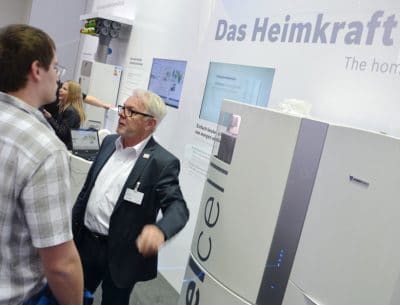The most important trade show of the heating and sanitation industry, the ISH in Frankfurt, Germany, showed from March 14 through 18 this year what kind of heating systems are in demand these days. Fuel cells did not seem to play much of a role at the event. Only one of the big manufacturers of heating systems made news in this segment, and what for news: Vaillant is on its way out (see Vaillant Puts Fuel Cell Heating on Ice). Spokesperson Martin Schellhorn explained: “Technologically, everything’s great, but the market isn’t becoming sustainable. So far, the benefits of economies of scale have not materialized.” Still, Vaillant would complete currently running projects (e.g., ene.field) and continue to maintain all installed systems thereafter.
The other exhibitors did not seem any more optimistic about the fuel cell’s outlook than Vaillant. The only thing Buderus and Junkers had to announce was that “more than a hundred” systems of both brands had been installed, as estimated by spokesperson Jörg Bonkowski.
Vaillant’s competitor Viessmann presented its fuel cell heating system Vitovalor together with a battery storage unit called Vitocharge. The combination of both devices is intended to provide more independence from the grid in residential buildings. Anyone who also buys a PV system can produce electricity during summer when the fuel cell operated based on heat demand shuts down due to a fully heated tank.
Elcore, based in the German state of Bavaria, painted a bit of a different picture. It was planning to create new sales channels, for which it had just established a partnership with Solvis, a manufacturer of heating systems from the solar industry. Several hundred installers are said to first undergo a one-day training course to install a combination of Elcore 2400 and SolvisMax, a system to be marketed through Solvis. The energy management system SolvisMax is a fully integrated heating device consisting of a 750-liter (or 198-gallon) stratified storage unit, a condensing boiler for peak loads and controls. Not a single watt will be lost, as the boiler is basically located inside the storage unit. Elcore’s fuel cell device is placed next to it as a backup heater.
About a week before the ISH started, Elcore announced that German energy corporation E.ON had become a strategic investor …
Even pellet boilers and solar systems were seemingly not as ubiquitous as they had been just a few years ago. In the minds of heating system suppliers, “environmental protection” and “innovation” seem to be inextricably linked with “heat pumps” and “internet connection” today.
HPS presents: Picea
HPS Home Power Solutions – a spin-off from Heliocentris, which had filed for bankruptcy (see also: The Break-Up of Heliocentris) – unveiled at the ISH a novel and comprehensive approach to supply nearly all of a building with electricity from solar energy and hydrogen. This system called Picea consists of a fuel cell, a battery storage unit, an electrolyzer and a hydrogen tank. The actual energy source is a PV system, which is not sold by HPS. Any solar power (10 kW for a four-people household) not used immediately will be stored in the battery. Once the battery is fully charged (at 25 kWh), the electrolyzer starts producing hydrogen. The H2 tank outside the house has a capacity from 350 to 1,000 kWh and requires four to six square meters (43 to 65 square feet) to set up. (more information will be available in the next issues of h2-international).
Author: Eva Augsten



























0 Comments